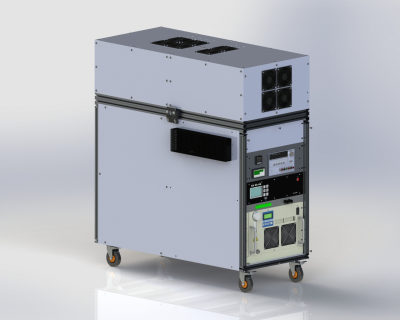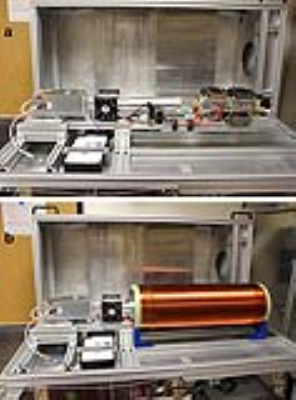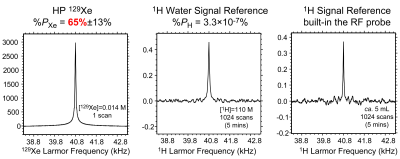2441
Next-Generation Automated Clinical-Scale Batch-Mode Xe-129 Hyperpolarizer1VUIIS, Vanderbilt University Medical Center, Nashville, TN, United States, 2Vanderbilt University Medical Center, Nashville, TN, United States, 3Southern Illinois University Carbondale, Carbondale, IL, United States, 4University of Nottingham, Nottingham, United Kingdom, 5Radiology, Vanderbilt University Medical Center, Nashville, TN, United States
Synopsis
Over the last two decades there have been many advances in the field of hyperpolarized (HP) noble gas production and imaging, largely enabled by the development of low-cost, high-power frequency-narrowed laser diode arrays (LDAs) and the improvement of 129Xe polarizer technology in general. Here we present the development and features of the new 3rd-generation Batch-Mode 129Xe hyperpolarizer. As with most previous 129Xe polarizers, the new device utilizes Spin Exchange Optical Pumping (SEOP), a process in which resonant, circularly polarized photons optically pump Rb electrons, which in turn hyperpolarize the 129Xe nuclear spins via hyperfine interactions (the “spin-exchange” process).
INTRODUCTION
There have been many recent advances in the field of hyperpolarized (HP) noble gas production and imaging, largely enabled by the development of low-cost, high-power frequency-narrowed laser diode arrays (LDAs) and the improvement of 129Xe polarizer technology in general. In particular, our team along with our collaborators previously have developed two generations of clinical-scale hyperpolarizers: an “open-source” prototype, and our “3D-printed” hyperpolarizer--each improving on the previous generation (see References), with the ultimate goal to develop a relatively low-cost, high-capacity 129Xe hyperpolarizer with fully automated operation that can deliver near-unity 129Xe nuclear spin polarization—making it attractive for both biomedical and basic research (including for potential clinical use). Here we report on the development and features of the new 3rd-generation batch-mode 129Xe hyperpolarizer dubbed “XeUS”, utilizing Spin Exchange Optical Pumping (SEOP), a process in which resonant, circularly polarized photons optically pump Rb electrons, which in turn hyperpolarize the 129Xe nuclear spins via hyperfine interactions (the “spin-exchange” process).METHODS
The new hyperpolarizer operates using a positive-pressure gas manifold with a pre-mixed 129Xe/N2 gas cylinder (e.g. using a 50:50 mix), which is employed to load a 0.5 L OP cell to >2000 Torr total gas pressure. This design allows the hyperpolarizer to generate up to 1 L/cycle of HP 129Xe mixture every ~30-40 minutes. The device chassis is relatively compact: 0.55 m (width) x 1.25 m (length) x 1.35 m (height), and the hyperpolarizer runs on a dedicated single 220 V (20 Amp) circuit, Figure 1. This device utilizes a micro-channel cooled 795 nm, 180 W LDA module (QPC Lasers) with spectral width (FWHM) of <0.2 nm, and with 2” expanding telescope optics to provide homogeneous illumination of the OP cell. The new design employs an aluminum heating jacket (vs. circulating air) that has direct thermal contact with the OP cell housed within it, which in turn is aligned concentrically to the laser (Figures 2 and 3). The aluminum jacket offers several advantages over a conventional forced-air oven: (i) it heats and cools the OP cell significantly faster, thus reducing polarization cycle times, (ii) it provides rf-shielding for the integrated 40.8 kHz in-situ NMR coil, (iii) it eliminates the need for additional anti-reflection-coated windows typically used in forced-air SEOP ovens (which can cause small but undesirable losses in laser intensity), and (iv) allows for more compact integration of in-situ near-IR and NMR sensors. The entire optical path resides in a “light-tight” portion of the chassis.
The hyperpolarizer employs a single solenoid B0 NMR magnet that is 8” OD and 22” long with field homogeneity of ~300 ppm over a 5 cm sphere, and integrated RF shielding. This magnet (<10 kg) produces a B0 of ~4 mT using < 0.2 kW. The hyperpolarizer runs on a custom-built micro-controller driver module allowing complete automation, monitoring, and control of all on-board devices, safety sensors/interlocks, and solenoid valves by using custom software. This device can be operated in fully automated or advanced-user (expert operating components individually) modes. Moreover, the hyperpolarizer software is web-browser based, and therefore can be run on a variety of computers (e.g., laptop, tablet, etc.) connected locally via USB or Wi-Fi, or remotely.
RESULTS
1) The hyperpolarizer allows for fast cooling and heating of the optical pumping cells (<5 mins) versus previous designs using forced air (>10 mins), which decreases the dead-time of the device. Moreover, the cooling of the gas mixture is accomplished under conditions of optical pumping with laser being ON at full power. Overall, 30-40 minute-long production cycle may be feasible. Moreover, the new new Aluminum jacket minimizes background RF noise (see in-situ NMR polarimetry, Figure 4) and allow more even (Figure 3), and more efficient thermal management of the optical pumping cell.
2) Figure 4 demonstrates the performance of the polarizer with 50:50 (2000 Torr) Xe:N2 mixture showing that %PXe of 65±13% is feasible. The in-cell 129Xe T1 in excess of 160 minutes ensures high levels of attainable %PXe under conditions of fast polarization build-up (with exponential buildup time constants of ca. 15 mins).
3) In-situ NMR detection of HP 129Xe as low as 14 kHz has been performed in this hyperpolarizer thanks to superb RF-shielding of the aluminum jacket and RF coil.
DISCUSSION & CONCLUSION
High (>60%) level of 129Xe polarization has been demonstrated with the new hyperpolarizer at high Xe density (~50%) for production of ~0.8 L batch of HP gas mixture. Significantly improved thermal management of the optical pumping cell has been achieved in the context of batch-mode (i.e. stopped-flow regime) SEOP hyperpolarization.Acknowledgements
We thank our collaborators Matthew S. Rosen (Harvard University), Sam Patz (Brigham and Women's Hospital) and others. Work at SIUC and Vanderbilt is supported by a DoD CDMRP Era of Hope Award W81XWH-12-1-0159/BC112431, W81XWH-15-1-0271 and W81XWH-15-1-0272, and 1F32EB021840-01, NSF CHE-1416268 and CHE-1416432, and University of Nottingham (UK) contract.References
1) Nikolaou, P.; Whiting, N.; Eschmann, N. A.; Chaffee, K. E.; Goodson, B. M. Generation of Laser-Polarized Xenon Using Fiber-Coupled Laser-Diode Arrays Narrowed with Integrated Volume Holographic Gratings. J. Magn. Reson. 2009, 197, 249-254.
2) Whiting, N.; Nikolaou, P.; Eschmann, N. A.; Barlow, M. J.; Lammert, R.; Ungar, J.; Hu, W.; Vaissie, L.; Goodson, B. M. Using Frequency-Narrowed, Tunable Laser Diode Arrays with Integrated Volume Holographic Gratings for Spin-Exchange Optical Pumping at High Resonant Fluxes and Xenon Densities. Appl. Phys. B-Lasers Opt. 2012, 106, 775-788.
3) Nikolaou, P.; Coffey, A. M.; Walkup, L. L.; Gust, B. M.; Whiting, N.; Newton, H.; Barcus, S.; Muradyan, I.; Dabaghyan, M.; Moroz, G. D., et al. Near-Unity Nuclear Polarization with an 'Open-Source' 129Xe Hyperpolarizer for NMR and MRI. Proc. Natl. Acad. Sci. U. S. A. 2013, 110, 14150-14155.
4) Nikolaou, P.; Coffey, A. M.; Barlow, M. J.; Rosen, M.; Goodson, B. M.; Chekmenev, E. Y. Temperature-Ramped 129Xe Spin Exchange Optical Pumping. Anal. Chem. 2014, 86, 8206–8212.
5) Nikolaou, P.; Coffey, A. M.; Ranta, K.; Walkup, L. L.; Gust, B.; Barlow, M. J.; Rosen, M. S.; Goodson, B. M.; Chekmenev, E. Y. Multi-Dimensional Mapping of Spin-Exchange Optical Pumping in Clinical-Scale Batch-Mode 129Xe Hyperpolarizers. J. Phys. Chem. B 2014, 118, 4809–4816.
6) Nikolaou, P.; Coffey, A. M.; Walkup, L. L.; Gust, B.; LaPierre, C.; Koehnemann, E.; Barlow, M. J.; Rosen, M. S.; Goodson, B. M.; Chekmenev, E. Y. A 3D-Printed High Power Nuclear Spin Polarizer. J. Am. Chem. Soc. 2014, 136 1636–1642.
7) Nikolaou, P.; Coffey, A. M.; Walkup, L. L.; Gust, B. M.; Whiting, N. R.; Newton, H.; Muradyan, I.; Dabaghyan, M.; Ranta, K.; Moroz, G., et al. Xena: An Automated 'Open-Source' 129Xe Hyperpolarizer for Clinical Use. Magn. Reson. Imaging 2014, 32, 541-550.
8) Goodson, B. M.; Whiting, N.; Newton, H.; Skinner, Jason Graham; Ranta, K.; Nikolaou, P.; Barlow, M. J.; Chekmenev, E. Y. Spin-Exchange Optical Pumping at High Xenon Densities and Laser Fluxes: Principles and Practice. In Hyperpolarized Xenon-129 Magnetic Resonance, Meersmann, T.; Brunner, E., Eds. Royal Society of Chemistry: Abingdon, UK, 2015; pp 96-121.
9) Nikolaou, P.; Goodson, B. M.; Chekmenev, E. Y. NMR Hyperpolarization Techniques for Biomedicine. Chem. Eur. J. 2015, 21, 3156-3166.
10) Barskiy, D. A.; Coffey, A. M.; Nikolaou, P.; Mikhaylov, D. M.; Goodson, B. M.; Branca, R. T.; Lu, G. J.; Shapiro, M. G.; Telkki, V.-V.; Zhivonitko, V. V., et al. NMR Hyperpolarization Techniques of Gases. Chem. Eur. J. 2017, 23, 725–751.
Figures



